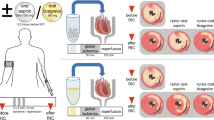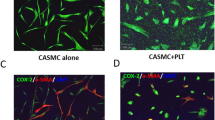Abstract
Background
Recent studies in rabbits have demonstrated that platelet P2Y12 receptor antagonists are cardioprotective, and that the mechanism is surprisingly not related to blockade of platelet aggregation but rather to triggering of the same signal transduction pathway seen in pre- and postconditioning. We wanted to determine whether this same cardioprotection could be documented in a primate model and whether the protection was limited to P2Y12 receptor antagonists or was a class effect.
Methods
Thirty-one macaque monkeys underwent 90-min LAD occlusion/4-h reperfusion.
Results
The platelet P2Y12 receptor blocker cangrelor started just prior to reperfusion significantly decreased infarction by an amount equivalent to that seen with ischemic postconditioning (p < 0.001). For any size of risk zone, infarct size in treated hearts was significantly smaller than that in control hearts. OM2, an investigational murine antibody against the primate collagen receptor glycoprotein (GP) VI, produced similar protection (p < 0.01) suggesting a class effect. Both cangrelor and OM2 were quite effective at blocking platelet aggregation (94 % and 97 %, respectively).
Conclusions
Thus in a primate model in which infarct size could be determined directly platelet anti-aggregatory agents are cardioprotective. The important implication of these investigations is that patients with acute myocardial infarction who are treated with platelet anti-aggregatory agents prior to revascularization may already be in a postconditioned state. This hypothesis may explain why in recent clinical trials postconditioning-mimetic interventions which were so protective in animal models had at best only a modest effect.



Similar content being viewed by others
References
Murry CE, Jennings RB, Reimer KA. Preconditioning with ischemia: a delay of lethal cell injury in ischemic myocardium. Circulation. 1986;74:1124–36.
Staat P, Rioufol G, Piot C, Cottin Y, Cung TT, L'Huillier I, et al. Postconditioning the human heart. Circulation. 2005;112:2143–8.
Piot C, Croisille P, Staat P, Thibault H, Rioufol G, Mewton N, et al. Effect of cyclosporine on reperfusion injury in acute myocardial infarction. N Engl J Med. 2008;359:473–81.
Kitakaze M, Asakura M, Kim J, Shintani Y, Asanuma H, Hamasaki T, et al. Human atrial natriuretic peptide and nicorandil as adjuncts to reperfusion treatment for acute myocardial infarction (J-WIND): two randomised trials. Lancet. 2007;370:1483–93.
Mochly-Rosen D, Grimes KV. Myocardial salvage in acute myocardial infarction–challenges in clinical translation. J Mol Cell Cardiol. 2011;51:451–3.
Yang X-M, Liu Y, Cui L, Yang X, Liu Y, Tandon N, et al. Platelet P2Y12 blockers confer direct postconditioning-like protection in reperfused rabbit hearts. J Cardiovasc Pharmacol Ther. 2013 (in press).
Tissier R, Cohen MV, Downey JM. Protecting the acutely ischemic myocardium beyond reperfusion therapies: are we any closer to realizing the dream of infarct size elimination? Arch Mal Coeur Vaiss. 2007;100:794–802.
Patti G, Bárczi G, Orlic D, Mangiacapra F, Colonna G, Pasceri V, et al. Outcome comparison of 600- and 300-mg loading doses of clopidogrel in patients undergoing primary percutaneous coronary intervention for ST-segment elevation myocardial infarction: results from the ARMYDA-6 MI (Antiplatelet therapy for Reducton of MYocardial Damage during Angioplasty-Myocardial Infarction) randomized study. J Am Coll Cardiol. 2011;58:1592–9.
Roubille F, Lairez O, Mewton N, Rioufol G, Ranc S, Sanchez I, et al. Cardioprotection by clopidogrel in acute ST-elevated myocardial infarction patients: a retrospective analysis. Basic Res Cardiol. 2012;107:275.
National Research Council. Guide for the care and use of laboratory animals. 7th ed. Washington, D.C: National Academy Press; 1996.
Yang X-M, Liu Y, Liu Y, Tandon N, Kambayashi J, Downey JM, et al. Attenuation of infarction in cynomolgus monkeys: preconditioning and postconditioning. Basic Res Cardiol. 2010;105:119–28.
Kleinschnitz C, Pozgajova M, Pham M, Bendszus M, Nieswandt B, Stoll G. Targeting platelets in acute experimental stroke: impact of glycoprotein Ib, VI, and IIb/IIIa blockade on infarct size, functional outcome, and intracranial bleeding. Circulation. 2007;115:2323–30.
Li H, Lockyer S, Concepcion A, Gong X, Takizawa H, Guertin M, et al. The Fab fragment of a novel anti-GPVI monoclonal antibody, OM4, reduces in vivo thrombosis without bleeding risk in rats. Arterioscler Thromb Vasc Biol. 2007;27:1199–205.
Weig H-J, Bott-Flügel L, Städele C, Winter K, Schmidt R, Gawaz M, et al. Impaired platelet function reduces myocardial infarct size in Gαq knock-out mice in vivo. J Mol Cell Cardiol. 2008;44:143–50.
Takaya N, Katoh Y, Iwabuchi K, Hayashi I, Konishi H, Itoh S, et al. Platelets activated by collagen through the immunoreceptor tyrosine-based activation motif in the Fc receptor γ-chain play a pivotal role in the development of myocardial ischemia-reperfusion injury. J Mol Cell Cardiol. 2005;39:856–64.
Li H, Takizawa H, Gong X, Concepcion A, Kambayashi J, Tandon N, et al. Platelet glycoprotein VI (GPVI) deletion reduces myocardial infarction in mice. Circulation. 2007;116(Suppl II):II–200.
Xu Y, Huo Y, Toufektsian M-C, Ramos SI, Ma Y, Tejani AD, et al. Activated platelets contribute importantly to myocardial reperfusion injury. Am J Physiol. 2006;290:H692–9.
Damman P, Woudstra P, Kuijt WJ, de Winter RJ, James SK. P2Y12 platelet inhibition in clinical practice. J Thromb Thrombolysis. 2012;33:143–53.
Freixa X, Bellera N, Ortiz-Pérez JT, Jiménez M, Paré C, Bosch X, et al. Ischaemic postconditioning revisited: lack of effects on infarct size following primary percutaneous coronary intervention. Eur Heart J. 2012;33:103–12.
Tarantini G, Favaretto E, Marra MP, Frigo AC, Napodano M, Cacciavillani L, et al. Postconditioning during coronary angioplasty in acute myocardial infarction: the POST-AMI trial. Int J Cardiol. 2012;162:33–8.
Kingma Jr JG, Plante S, Bogaty P. Platelet GPIIb/IIIa receptor blockade reduces infarct size in a canine model of ischemia-reperfusion. J Am Coll Cardiol. 2000;36:2317–24.
Kunichika H, Ben-Yehuda O, Lafitte S, Kunichika N, Peters B, DeMaria AN. Effects of glycoprotein IIb/IIIa inhibition on microvascular flow after coronary reperfusion. A quantitative myocardial contrast echocardiography study. J Am Coll Cardiol. 2004;43:276–83.
Sakuma T, Sari I, Goodman CN, Lindner JR, Klibanov AL, Kaul S. Simultaneous integrin αvβ3 and glycoprotein IIb/IIIa inhibition causes reduction in infarct size in a model of acute coronary thrombosis and primary angioplasty. Cardiovasc Res. 2005;66:552–61.
Reimer KA, Jennings RB. The “wavefront phenomenon” of myocardial ischemic cell death. II. Transmural progression of necrosis within the framework of ischemic bed size (myocardium at risk) and collateral flow. Lab Invest. 1979;40:633–44.
Schwartz LM, Sebbag L, Jennings RB, Reimer KA. Duration and reinstatement of myocardial protection against infarction by ischemic preconditioning in open chest dogs. J Mol Cell Cardiol. 2001;33:1561–70.
Barrabés JA, Garcia-Dorado D, Mirabet M, Inserte J, Agulló L, Soriano B, et al. Antagonism of selectin function attenuates microvascular platelet deposition and platelet-mediated myocardial injury after transient ischemia. J Am Coll Cardiol. 2005;45:293–9.
Barrabés JA, Garcia-Dorado D, Mirabet M, Lidón R-M, Soriano B, Ruiz-Meana M, et al. Lack of effect of glycoprotein IIb/IIIa blockade on myocardial platelet or polymorphonuclear leukocyte accumulation and on infarct size after transient coronary occlusion in pigs. J Am Coll Cardiol. 2002;39:157–65.
Yang Y-J, Zhao J-L, You S-J, Wu Y-J, Jing Z-C, Yang W-X, et al. Different effects of tirofiban and aspirin plus clopidogrel on myocardial no-reflow in a mini-swine model of acute myocardial infarction and reperfusion. Heart. 2006;92:1131–7.
Barrabés JA, Inserte J, Mirabet M, Quiroga A, Hernando V, Figueras J, et al. Antagonism of P2Y12 or GPIIb/IIIa receptors reduces platelet-mediated myocardial injury after ischaemia and reperfusion in isolated rat hearts. Thromb Haemost. 2010;104:128–35.
Acknowledgments
This study was supported in part by grant HL-20648 from the Heart, Lung and Blood Institute of the National Institutes of Health and by funds supplied by Otsuka Maryland Medicinal Labs., Inc., Rockville, MD. Cangrelor was synthesized by a private firm.
Disclosures
Monkey studies were funded by a contract with Otsuka Maryland Medicinal Labs, Rockville, MD.
Author information
Authors and Affiliations
Corresponding author
Rights and permissions
About this article
Cite this article
Yang, XM., Liu, Y., Cui, L. et al. Two Classes of Anti-Platelet Drugs Reduce Anatomical Infarct Size in Monkey Hearts. Cardiovasc Drugs Ther 27, 109–115 (2013). https://doi.org/10.1007/s10557-012-6436-7
Published:
Issue Date:
DOI: https://doi.org/10.1007/s10557-012-6436-7




